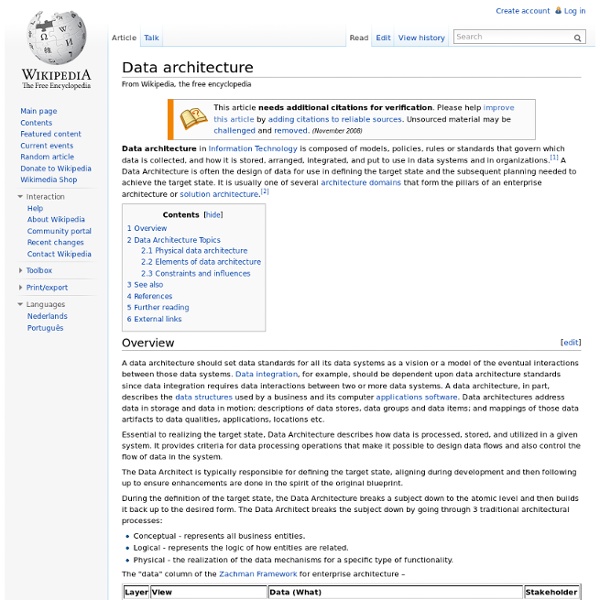Role of the Data Architect - Information Management Magazine Article
Business process modeling
Business process modeling (BPM) in systems engineering is the activity of representing processes of an enterprise, so that the current process may be analyzed or improved. BPM is typically performed by business analysts, who provide expertise in the modeling discipline; by subject matter experts, who have specialized knowledge of the processes being modeled; or more commonly by a team comprising both. The business objective is often to increase process speed or reduce cycle time; to increase quality; or to reduce costs, such as labor, materials, scrap, or capital costs. In practice, a management decision to invest in business process modeling is often motivated by the need to document requirements for an information technology project. Change management programs are typically involved to put any improved business processes into practice. History[edit] BPM topics[edit] Business model[edit] A business model is a framework for creating economic, social, and/or other forms of value.
What is the role of an enterprise data architect?
Modelo em cascata
Origem: Wikipédia, a enciclopédia livre. O modelo em cascata é um modelo de desenvolvimento de software seqüencial no qual o desenvolvimento é visto como um fluir constante para frente (como uma cascata) através das fases de análise de requisitos, projeto, implementação, testes (validação), integração, e manutenção de software. A origem do termo cascata é frequentemente citado como sendo um artigo publicado em 1970 por W. W. Royce; ironicamente, Royce defendia um abordagem iterativa para o desenvolvimento de software e nem mesmo usou o termo cascata. História do modelo em cascata[editar | editar código-fonte] Em 1970 Royce propôs o que é agora popularmente designado no modelo em cascata como um conceito inicial, um modelo no qual ele argumentava ser defeituoso. Uso do modelo cascata[editar | editar código-fonte] O Modelo em cascata estático. No modelo em cascata original de Royce, as seguintes fases são seguidas em perfeita ordem:
Software Architecture Notes - Architecture Roles
Ask two people what a developer does and you will pretty much the same answers. So, too, if you ask what a tester does. Or a project manager. Sure, there will be differences in wording and emphasis. But the basic answers will be the same: a developer writes code, a tester tests things, the project manager allocates resources to tasks, or something to that effect. But there is a lot more spread if you ask what an architect does. And then there are the variations... Do you mean an application architect, or a data architect? Here is another murky bit. This is too big a mess to sort out in one go. Before getting into the meat of things, a bit of context may be in order. Second: since the subject is software project architects it is worth knowing what kind of projects. There are some really interesting kinds of projects that are not on this list. Hopefully that gives you some idea where this is coming from. Architecture is a Separate Technical Responsibility HE: "Maybe in some sense.
Enterprise architecture planning
Levels of Enterprise Architecture Planning.[1] Enterprise Architecture Planning (EAP) in Enterprise Architecture is the planning process of defining architectures for the use of information in support of the business and the plan for implementing those architectures.[2] Overview[edit] One of the earlier professional practitioners in the field of system architecture Steven H. Spewak in 1992 defined Enterprise Architecture Planning (EAP) as "the process of defining architectures for the use of information in support of the business and the plan for implementing those architectures. This hierarchy of activity is represented in the figure above, in which the layers are implemented in order, from top to bottom. EAP topics[edit] Zachman framework[edit] EAP defines the blueprint for subsequent design and implementation and it places the planning/defining stages into a framework. EAP components[edit] Enterprise Architecture Planning model consists of four levels: EAP methodology[edit] See also[edit]
Data architect
A data architect in Information Technology is a person responsible for ensuring that the data assets of an organization are supported by a data architecture that aids the organization in achieving its strategic goals. The data architecture should cover databases, data integration and the means to get to the data. Usually the data architect achieves his/her goals via setting enterprise data standards. The definition of an IT architecture used in ANSI/IEEE Std 1471-2000 is: The fundamental organization of a system, embodied in its components, their relationships to each other and the environment, and the principles governing its design and evolution., where the data architect primarily focuses on the aspects related to data. In TOGAF (the Open Group Architecture Framework) [1], architecture has two meanings depending upon its contextual usage: Some fundamental skills of a Data Architect are: Data architects usually have experience in one or more of the following technologies:
Processo de desenvolvimento de software
Origem: Wikipédia, a enciclopédia livre. Um processo de desenvolvimento de software é um conjunto de atividades, parcialmente ordenadas, com a finalidade de obter um produto de software. É estudado dentro da área de Engenharia de Software, sendo considerado um dos principais mecanismos para se obter software de qualidade e cumprir corretamente os contratos de desenvolvimento, sendo uma das respostas técnicas adequadas para resolver a Crise do software. Passos/Atividades Processo[editar | editar código-fonte] Análise Econômica[editar | editar código-fonte] Análise de requisitos de software[editar | editar código-fonte] A extração dos requisitos de um cliente Especificação[editar | editar código-fonte] A especificação é a tarefa de descrever precisamente o software que será escrito, preferencialmente de uma forma matematicamente rigorosa. Arquitetura de Software[editar | editar código-fonte] A arquitetura de um sistema de software remete a uma representação abstrata daquele sistema.



